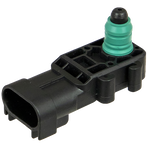How to Spot a Faulty
Fuel Tank Pressure Sensor
The fuel tank pressure (FTP) sensor is an important part of the evaporative emissions control system that is designed to capture unburnt fuel vapors and reintroduce them back into the fuel system. The fuel tank pressure sensor is responsible for detecting leaks in the fuel system, whether it be an evaporative leak or bad seal on the fuel cap. Once the FTP detects a leak in the fuel tank/system, it alerts the ECU to trigger a “Check Engine” light.
Signs of a faulty fuel tank pressure sensor include:
Common reasons for failure:
Over time a faulty fuel tank pressure sensor will cause low fuel efficiency, trouble starting the vehicle and/or stalling, and eventually keep the vehicle from starting. In states that require emissions tests, a faulty fuel tank pressure sensor may cause a failed emissions test because it is an integral part of the evaporative emissions control system.
Signs of a faulty fuel tank pressure sensor include:
- “Check Engine” Light Turns On
- Hard to Start Vehicle
- Vehicle is Stalling
- Low Fuel Efficiency/Weak Acceleration
Common reasons for failure:
- Overexposure to extreme temperatures, weather, vibration, and/or corrosive fuel vapors
- Over filling the fuel tank will cause fuel to overflow into the charcoal canister and other overflow lines can cause the sensor to fail
Over time a faulty fuel tank pressure sensor will cause low fuel efficiency, trouble starting the vehicle and/or stalling, and eventually keep the vehicle from starting. In states that require emissions tests, a faulty fuel tank pressure sensor may cause a failed emissions test because it is an integral part of the evaporative emissions control system.
| gpd_tech_tip_125-fuel_tank_pressure_sensor-common_reasons_for_failure.pdf |




